Taxation Law: Partnership Net Income and Fringe Benefits Tax
VerifiedAdded on 2023/04/23
|12
|2589
|64
AI Summary
This document discusses the computation of partnership net income and the liability of employers for fringe benefits tax under the FBTAA 1986. It covers the rules and applications of sections 90, 995-1, 6-5, 8-1, and 25-10 of the ITAA 1997 and sections 20, 23, 25, and 27 of the FBTAA 1986.
Contribute Materials
Your contribution can guide someone’s learning journey. Share your
documents today.
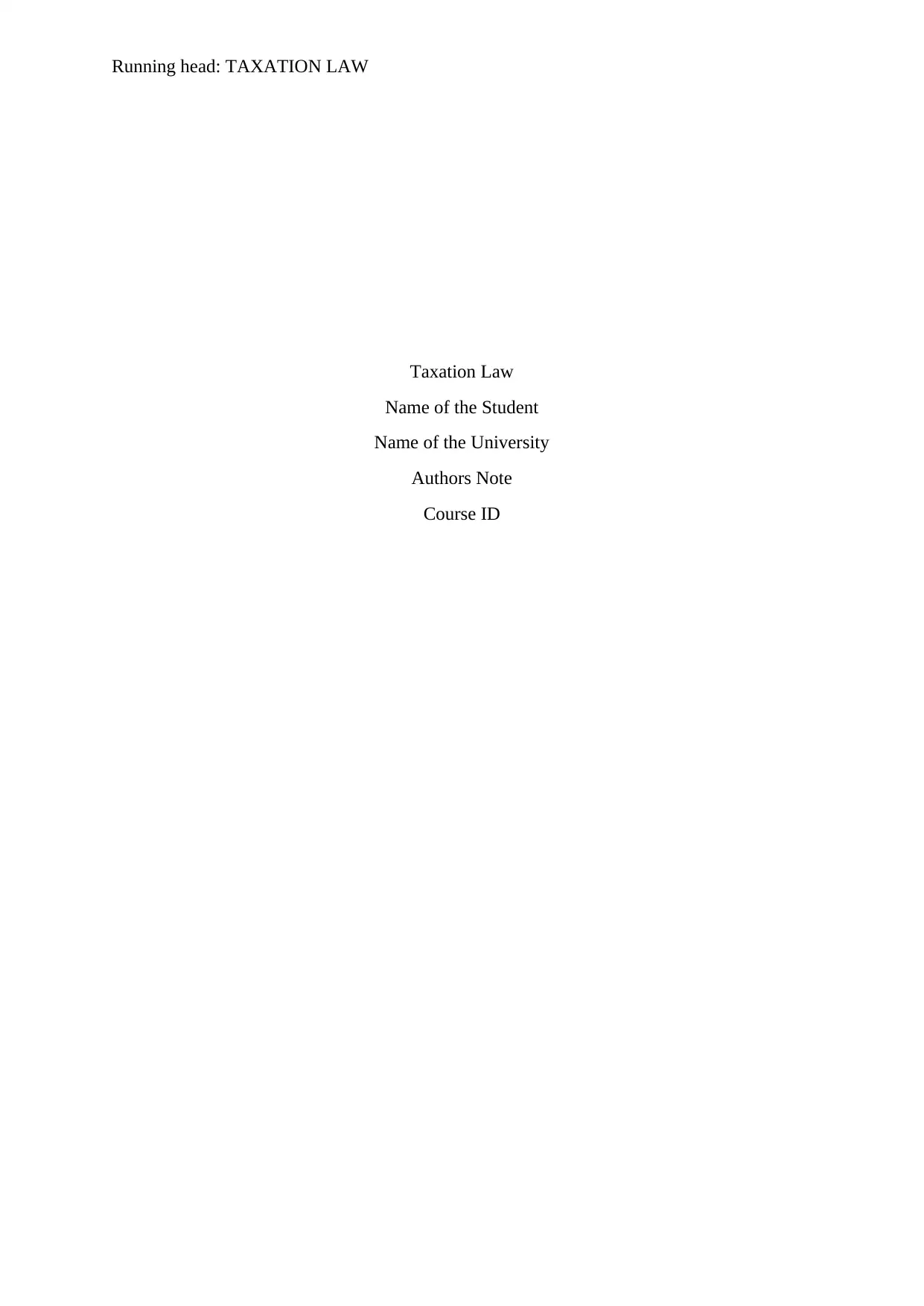
Running head: TAXATION LAW
Taxation Law
Name of the Student
Name of the University
Authors Note
Course ID
Taxation Law
Name of the Student
Name of the University
Authors Note
Course ID
Secure Best Marks with AI Grader
Need help grading? Try our AI Grader for instant feedback on your assignments.
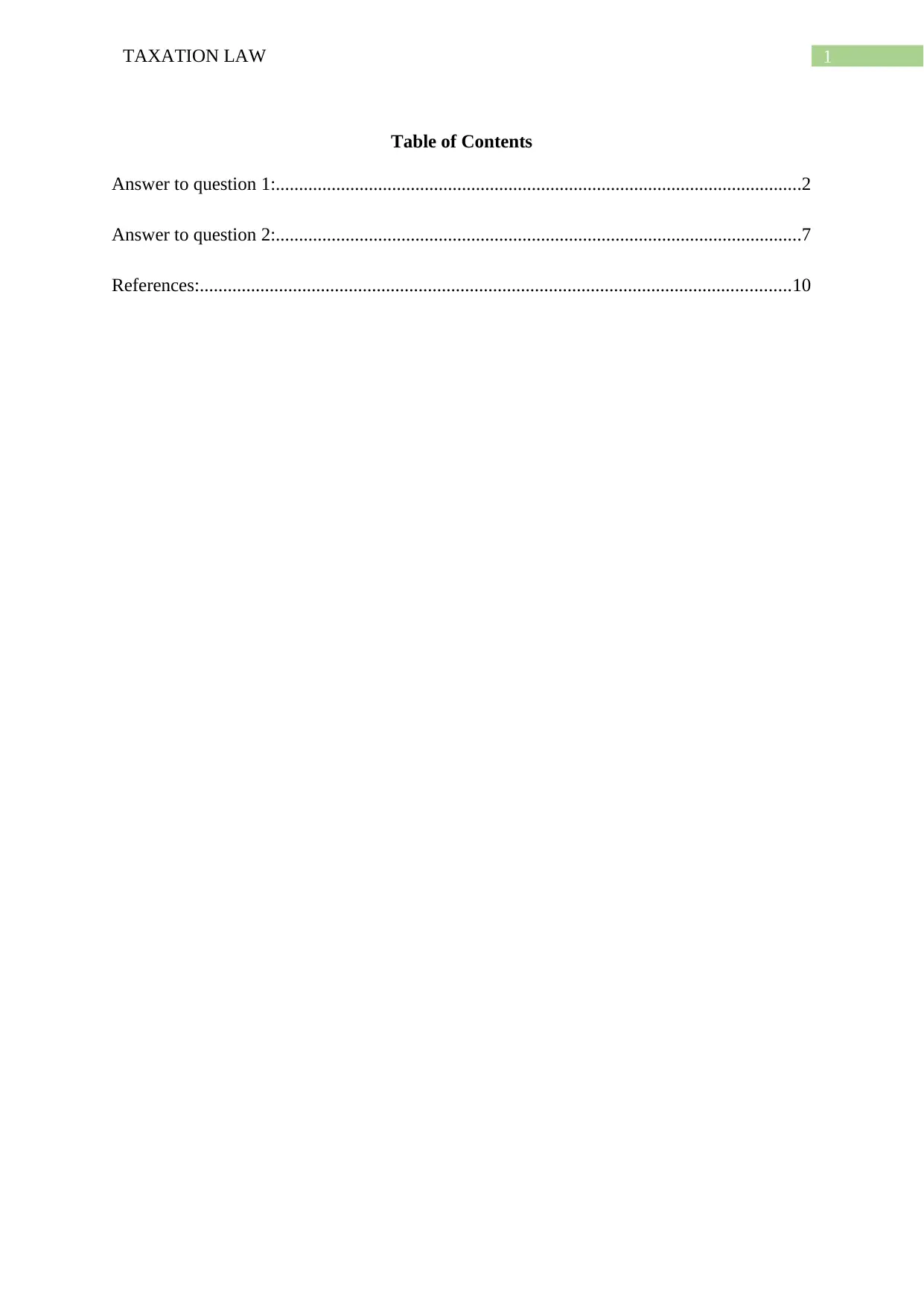
1TAXATION LAW
Table of Contents
Answer to question 1:.................................................................................................................2
Answer to question 2:.................................................................................................................7
References:...............................................................................................................................10
Table of Contents
Answer to question 1:.................................................................................................................2
Answer to question 2:.................................................................................................................7
References:...............................................................................................................................10
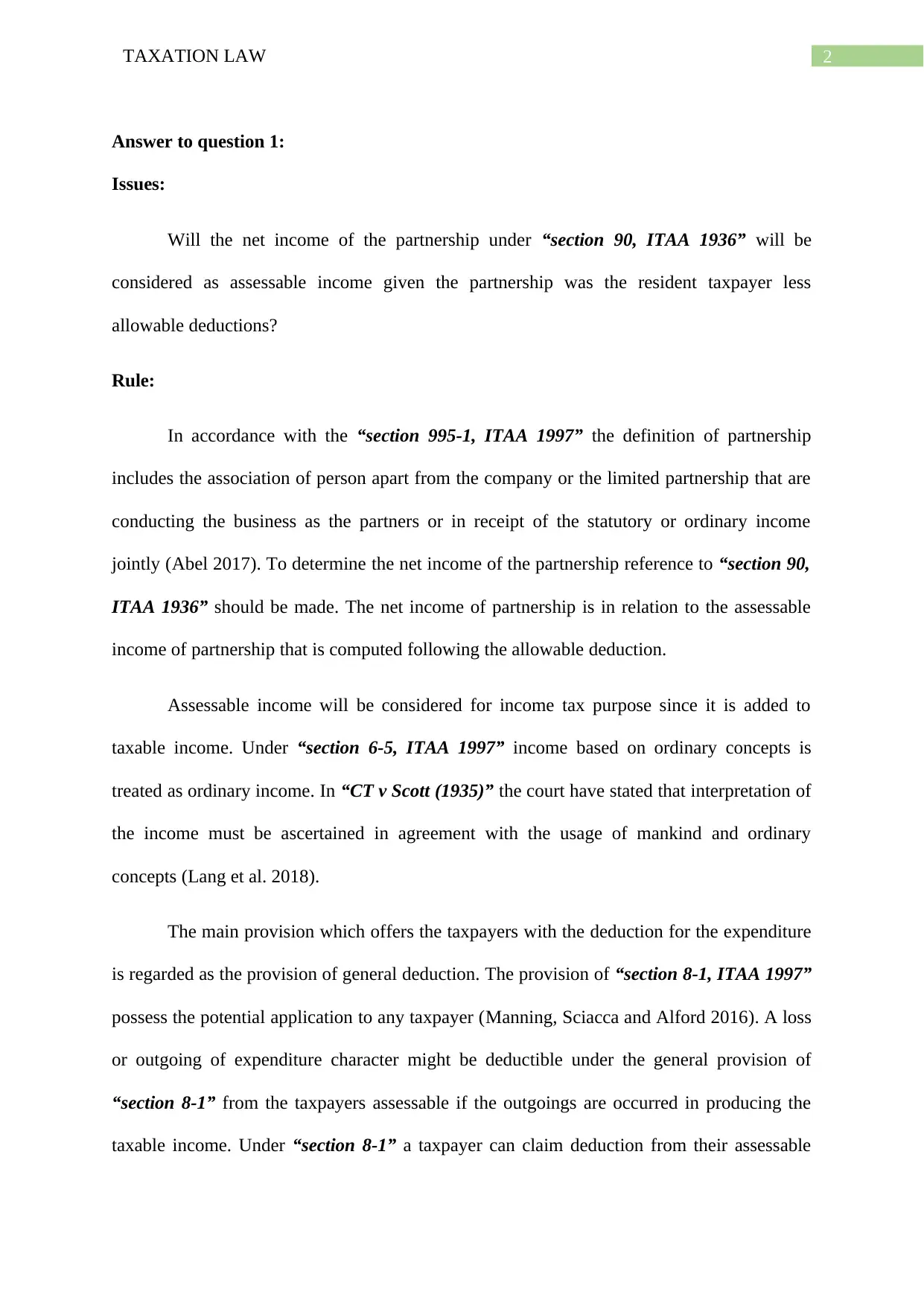
2TAXATION LAW
Answer to question 1:
Issues:
Will the net income of the partnership under “section 90, ITAA 1936” will be
considered as assessable income given the partnership was the resident taxpayer less
allowable deductions?
Rule:
In accordance with the “section 995-1, ITAA 1997” the definition of partnership
includes the association of person apart from the company or the limited partnership that are
conducting the business as the partners or in receipt of the statutory or ordinary income
jointly (Abel 2017). To determine the net income of the partnership reference to “section 90,
ITAA 1936” should be made. The net income of partnership is in relation to the assessable
income of partnership that is computed following the allowable deduction.
Assessable income will be considered for income tax purpose since it is added to
taxable income. Under “section 6-5, ITAA 1997” income based on ordinary concepts is
treated as ordinary income. In “CT v Scott (1935)” the court have stated that interpretation of
the income must be ascertained in agreement with the usage of mankind and ordinary
concepts (Lang et al. 2018).
The main provision which offers the taxpayers with the deduction for the expenditure
is regarded as the provision of general deduction. The provision of “section 8-1, ITAA 1997”
possess the potential application to any taxpayer (Manning, Sciacca and Alford 2016). A loss
or outgoing of expenditure character might be deductible under the general provision of
“section 8-1” from the taxpayers assessable if the outgoings are occurred in producing the
taxable income. Under “section 8-1” a taxpayer can claim deduction from their assessable
Answer to question 1:
Issues:
Will the net income of the partnership under “section 90, ITAA 1936” will be
considered as assessable income given the partnership was the resident taxpayer less
allowable deductions?
Rule:
In accordance with the “section 995-1, ITAA 1997” the definition of partnership
includes the association of person apart from the company or the limited partnership that are
conducting the business as the partners or in receipt of the statutory or ordinary income
jointly (Abel 2017). To determine the net income of the partnership reference to “section 90,
ITAA 1936” should be made. The net income of partnership is in relation to the assessable
income of partnership that is computed following the allowable deduction.
Assessable income will be considered for income tax purpose since it is added to
taxable income. Under “section 6-5, ITAA 1997” income based on ordinary concepts is
treated as ordinary income. In “CT v Scott (1935)” the court have stated that interpretation of
the income must be ascertained in agreement with the usage of mankind and ordinary
concepts (Lang et al. 2018).
The main provision which offers the taxpayers with the deduction for the expenditure
is regarded as the provision of general deduction. The provision of “section 8-1, ITAA 1997”
possess the potential application to any taxpayer (Manning, Sciacca and Alford 2016). A loss
or outgoing of expenditure character might be deductible under the general provision of
“section 8-1” from the taxpayers assessable if the outgoings are occurred in producing the
taxable income. Under “section 8-1” a taxpayer can claim deduction from their assessable
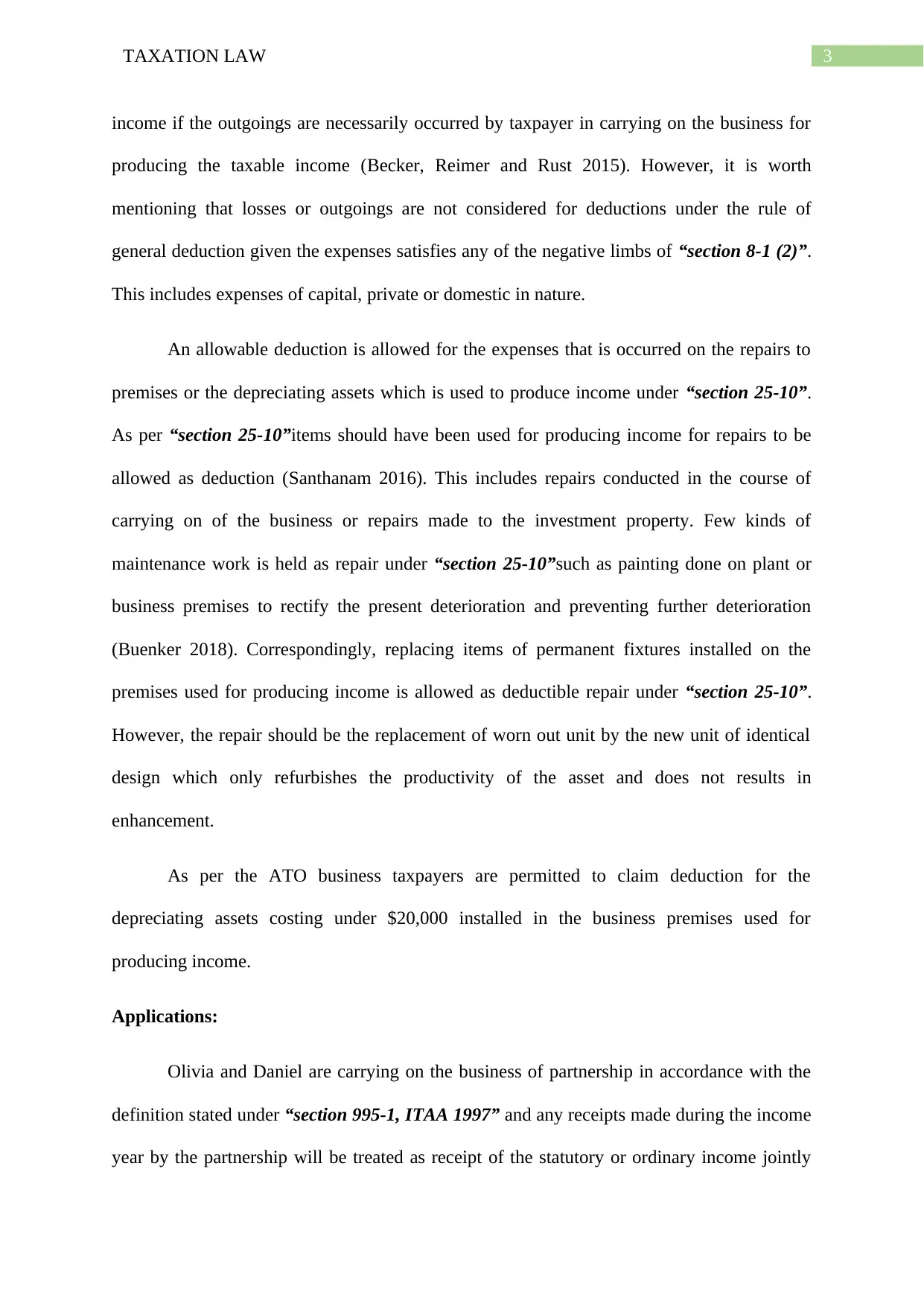
3TAXATION LAW
income if the outgoings are necessarily occurred by taxpayer in carrying on the business for
producing the taxable income (Becker, Reimer and Rust 2015). However, it is worth
mentioning that losses or outgoings are not considered for deductions under the rule of
general deduction given the expenses satisfies any of the negative limbs of “section 8-1 (2)”.
This includes expenses of capital, private or domestic in nature.
An allowable deduction is allowed for the expenses that is occurred on the repairs to
premises or the depreciating assets which is used to produce income under “section 25-10”.
As per “section 25-10”items should have been used for producing income for repairs to be
allowed as deduction (Santhanam 2016). This includes repairs conducted in the course of
carrying on of the business or repairs made to the investment property. Few kinds of
maintenance work is held as repair under “section 25-10”such as painting done on plant or
business premises to rectify the present deterioration and preventing further deterioration
(Buenker 2018). Correspondingly, replacing items of permanent fixtures installed on the
premises used for producing income is allowed as deductible repair under “section 25-10”.
However, the repair should be the replacement of worn out unit by the new unit of identical
design which only refurbishes the productivity of the asset and does not results in
enhancement.
As per the ATO business taxpayers are permitted to claim deduction for the
depreciating assets costing under $20,000 installed in the business premises used for
producing income.
Applications:
Olivia and Daniel are carrying on the business of partnership in accordance with the
definition stated under “section 995-1, ITAA 1997” and any receipts made during the income
year by the partnership will be treated as receipt of the statutory or ordinary income jointly
income if the outgoings are necessarily occurred by taxpayer in carrying on the business for
producing the taxable income (Becker, Reimer and Rust 2015). However, it is worth
mentioning that losses or outgoings are not considered for deductions under the rule of
general deduction given the expenses satisfies any of the negative limbs of “section 8-1 (2)”.
This includes expenses of capital, private or domestic in nature.
An allowable deduction is allowed for the expenses that is occurred on the repairs to
premises or the depreciating assets which is used to produce income under “section 25-10”.
As per “section 25-10”items should have been used for producing income for repairs to be
allowed as deduction (Santhanam 2016). This includes repairs conducted in the course of
carrying on of the business or repairs made to the investment property. Few kinds of
maintenance work is held as repair under “section 25-10”such as painting done on plant or
business premises to rectify the present deterioration and preventing further deterioration
(Buenker 2018). Correspondingly, replacing items of permanent fixtures installed on the
premises used for producing income is allowed as deductible repair under “section 25-10”.
However, the repair should be the replacement of worn out unit by the new unit of identical
design which only refurbishes the productivity of the asset and does not results in
enhancement.
As per the ATO business taxpayers are permitted to claim deduction for the
depreciating assets costing under $20,000 installed in the business premises used for
producing income.
Applications:
Olivia and Daniel are carrying on the business of partnership in accordance with the
definition stated under “section 995-1, ITAA 1997” and any receipts made during the income
year by the partnership will be treated as receipt of the statutory or ordinary income jointly
Secure Best Marks with AI Grader
Need help grading? Try our AI Grader for instant feedback on your assignments.
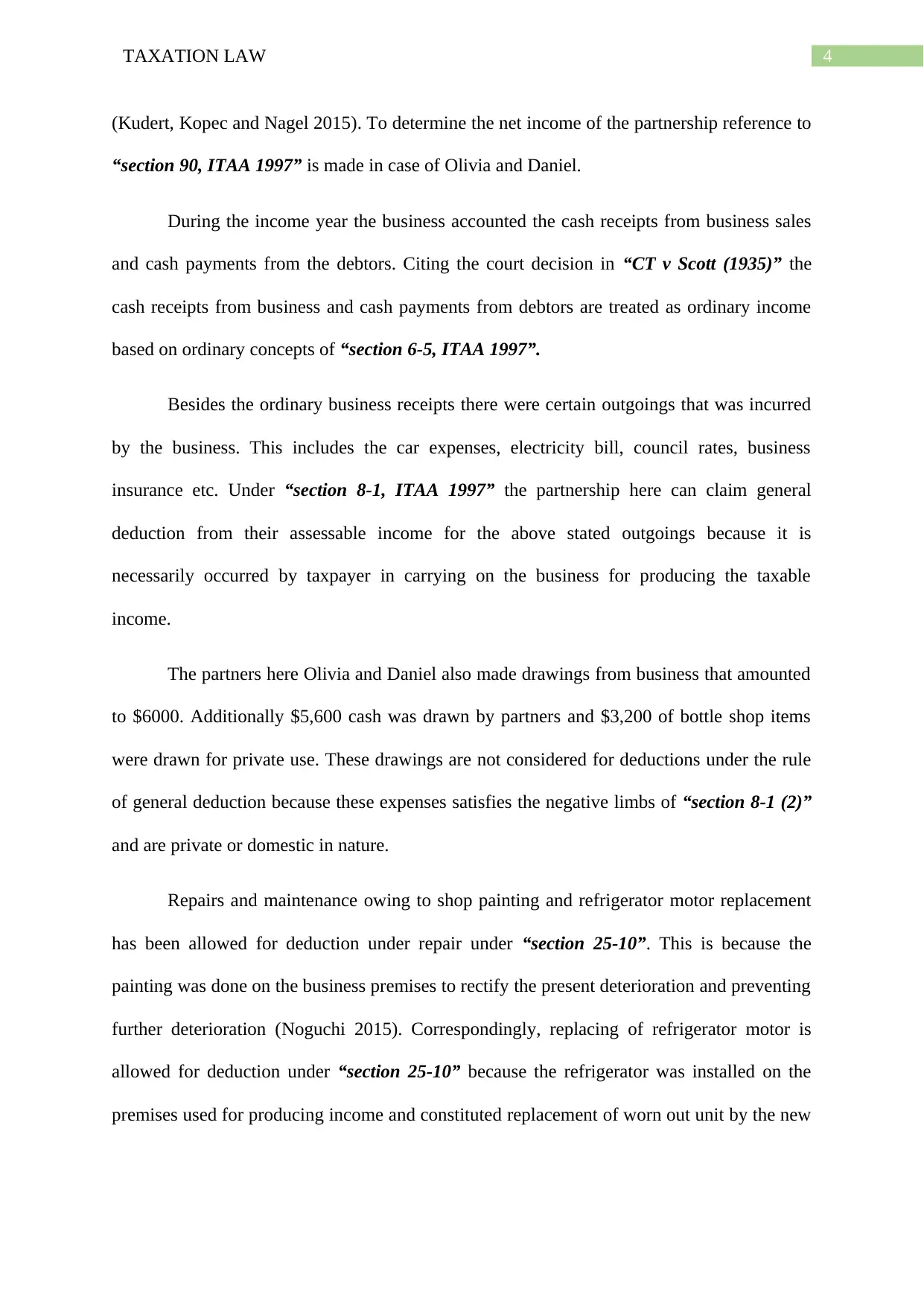
4TAXATION LAW
(Kudert, Kopec and Nagel 2015). To determine the net income of the partnership reference to
“section 90, ITAA 1997” is made in case of Olivia and Daniel.
During the income year the business accounted the cash receipts from business sales
and cash payments from the debtors. Citing the court decision in “CT v Scott (1935)” the
cash receipts from business and cash payments from debtors are treated as ordinary income
based on ordinary concepts of “section 6-5, ITAA 1997”.
Besides the ordinary business receipts there were certain outgoings that was incurred
by the business. This includes the car expenses, electricity bill, council rates, business
insurance etc. Under “section 8-1, ITAA 1997” the partnership here can claim general
deduction from their assessable income for the above stated outgoings because it is
necessarily occurred by taxpayer in carrying on the business for producing the taxable
income.
The partners here Olivia and Daniel also made drawings from business that amounted
to $6000. Additionally $5,600 cash was drawn by partners and $3,200 of bottle shop items
were drawn for private use. These drawings are not considered for deductions under the rule
of general deduction because these expenses satisfies the negative limbs of “section 8-1 (2)”
and are private or domestic in nature.
Repairs and maintenance owing to shop painting and refrigerator motor replacement
has been allowed for deduction under repair under “section 25-10”. This is because the
painting was done on the business premises to rectify the present deterioration and preventing
further deterioration (Noguchi 2015). Correspondingly, replacing of refrigerator motor is
allowed for deduction under “section 25-10” because the refrigerator was installed on the
premises used for producing income and constituted replacement of worn out unit by the new
(Kudert, Kopec and Nagel 2015). To determine the net income of the partnership reference to
“section 90, ITAA 1997” is made in case of Olivia and Daniel.
During the income year the business accounted the cash receipts from business sales
and cash payments from the debtors. Citing the court decision in “CT v Scott (1935)” the
cash receipts from business and cash payments from debtors are treated as ordinary income
based on ordinary concepts of “section 6-5, ITAA 1997”.
Besides the ordinary business receipts there were certain outgoings that was incurred
by the business. This includes the car expenses, electricity bill, council rates, business
insurance etc. Under “section 8-1, ITAA 1997” the partnership here can claim general
deduction from their assessable income for the above stated outgoings because it is
necessarily occurred by taxpayer in carrying on the business for producing the taxable
income.
The partners here Olivia and Daniel also made drawings from business that amounted
to $6000. Additionally $5,600 cash was drawn by partners and $3,200 of bottle shop items
were drawn for private use. These drawings are not considered for deductions under the rule
of general deduction because these expenses satisfies the negative limbs of “section 8-1 (2)”
and are private or domestic in nature.
Repairs and maintenance owing to shop painting and refrigerator motor replacement
has been allowed for deduction under repair under “section 25-10”. This is because the
painting was done on the business premises to rectify the present deterioration and preventing
further deterioration (Noguchi 2015). Correspondingly, replacing of refrigerator motor is
allowed for deduction under “section 25-10” because the refrigerator was installed on the
premises used for producing income and constituted replacement of worn out unit by the new
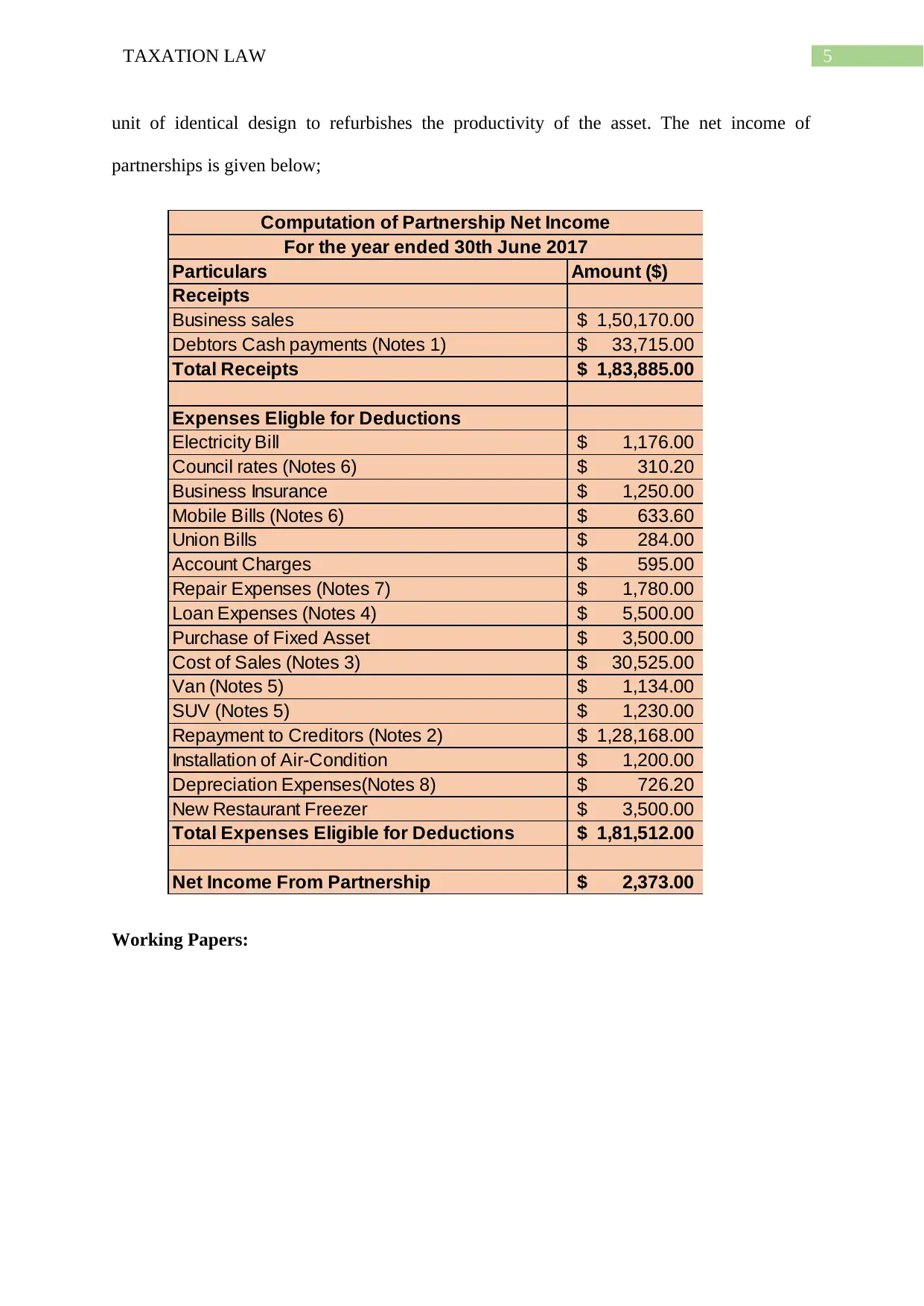
5TAXATION LAW
unit of identical design to refurbishes the productivity of the asset. The net income of
partnerships is given below;
Particulars Amount ($)
Receipts
Business sales 1,50,170.00$
Debtors Cash payments (Notes 1) 33,715.00$
Total Receipts 1,83,885.00$
Expenses Eligble for Deductions
Electricity Bill 1,176.00$
Council rates (Notes 6) 310.20$
Business Insurance 1,250.00$
Mobile Bills (Notes 6) 633.60$
Union Bills 284.00$
Account Charges 595.00$
Repair Expenses (Notes 7) 1,780.00$
Loan Expenses (Notes 4) 5,500.00$
Purchase of Fixed Asset 3,500.00$
Cost of Sales (Notes 3) 30,525.00$
Van (Notes 5) 1,134.00$
SUV (Notes 5) 1,230.00$
Repayment to Creditors (Notes 2) 1,28,168.00$
Installation of Air-Condition 1,200.00$
Depreciation Expenses(Notes 8) 726.20$
New Restaurant Freezer 3,500.00$
Total Expenses Eligible for Deductions 1,81,512.00$
Net Income From Partnership 2,373.00$
Computation of Partnership Net Income
For the year ended 30th June 2017
Working Papers:
unit of identical design to refurbishes the productivity of the asset. The net income of
partnerships is given below;
Particulars Amount ($)
Receipts
Business sales 1,50,170.00$
Debtors Cash payments (Notes 1) 33,715.00$
Total Receipts 1,83,885.00$
Expenses Eligble for Deductions
Electricity Bill 1,176.00$
Council rates (Notes 6) 310.20$
Business Insurance 1,250.00$
Mobile Bills (Notes 6) 633.60$
Union Bills 284.00$
Account Charges 595.00$
Repair Expenses (Notes 7) 1,780.00$
Loan Expenses (Notes 4) 5,500.00$
Purchase of Fixed Asset 3,500.00$
Cost of Sales (Notes 3) 30,525.00$
Van (Notes 5) 1,134.00$
SUV (Notes 5) 1,230.00$
Repayment to Creditors (Notes 2) 1,28,168.00$
Installation of Air-Condition 1,200.00$
Depreciation Expenses(Notes 8) 726.20$
New Restaurant Freezer 3,500.00$
Total Expenses Eligible for Deductions 1,81,512.00$
Net Income From Partnership 2,373.00$
Computation of Partnership Net Income
For the year ended 30th June 2017
Working Papers:
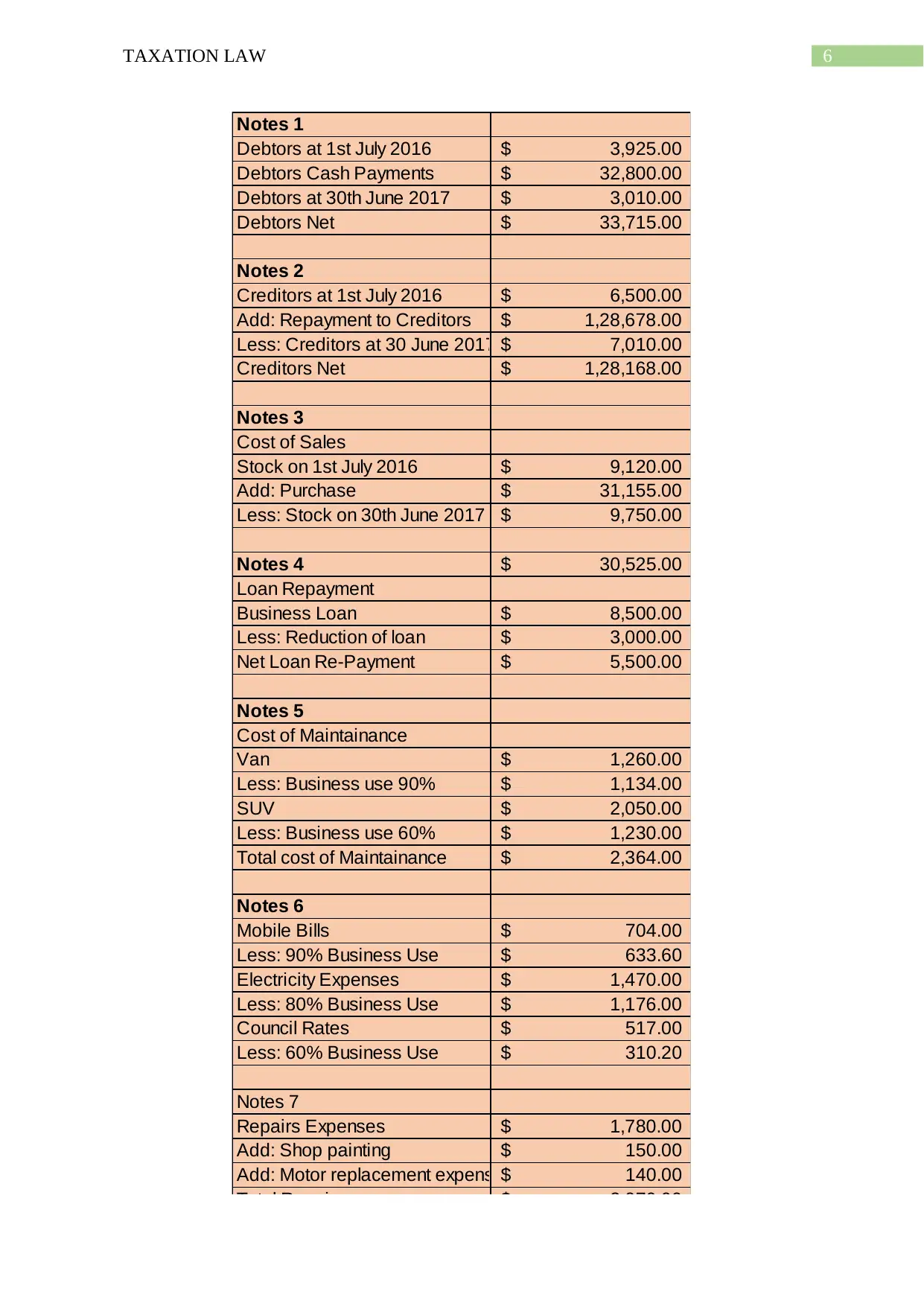
6TAXATION LAW
Notes 1
Debtors at 1st July 2016 3,925.00$
Debtors Cash Payments 32,800.00$
Debtors at 30th June 2017 3,010.00$
Debtors Net 33,715.00$
Notes 2
Creditors at 1st July 2016 6,500.00$
Add: Repayment to Creditors 1,28,678.00$
Less: Creditors at 30 June 2017 7,010.00$
Creditors Net 1,28,168.00$
Notes 3
Cost of Sales
Stock on 1st July 2016 9,120.00$
Add: Purchase 31,155.00$
Less: Stock on 30th June 2017 9,750.00$
Notes 4 30,525.00$
Loan Repayment
Business Loan 8,500.00$
Less: Reduction of loan 3,000.00$
Net Loan Re-Payment 5,500.00$
Notes 5
Cost of Maintainance
Van 1,260.00$
Less: Business use 90% 1,134.00$
SUV 2,050.00$
Less: Business use 60% 1,230.00$
Total cost of Maintainance 2,364.00$
Notes 6
Mobile Bills 704.00$
Less: 90% Business Use 633.60$
Electricity Expenses 1,470.00$
Less: 80% Business Use 1,176.00$
Council Rates 517.00$
Less: 60% Business Use 310.20$
Notes 7
Repairs Expenses 1,780.00$
Add: Shop painting 150.00$
Add: Motor replacement expenses 140.00$
Total Repairs 2,070.00$
Notes 1
Debtors at 1st July 2016 3,925.00$
Debtors Cash Payments 32,800.00$
Debtors at 30th June 2017 3,010.00$
Debtors Net 33,715.00$
Notes 2
Creditors at 1st July 2016 6,500.00$
Add: Repayment to Creditors 1,28,678.00$
Less: Creditors at 30 June 2017 7,010.00$
Creditors Net 1,28,168.00$
Notes 3
Cost of Sales
Stock on 1st July 2016 9,120.00$
Add: Purchase 31,155.00$
Less: Stock on 30th June 2017 9,750.00$
Notes 4 30,525.00$
Loan Repayment
Business Loan 8,500.00$
Less: Reduction of loan 3,000.00$
Net Loan Re-Payment 5,500.00$
Notes 5
Cost of Maintainance
Van 1,260.00$
Less: Business use 90% 1,134.00$
SUV 2,050.00$
Less: Business use 60% 1,230.00$
Total cost of Maintainance 2,364.00$
Notes 6
Mobile Bills 704.00$
Less: 90% Business Use 633.60$
Electricity Expenses 1,470.00$
Less: 80% Business Use 1,176.00$
Council Rates 517.00$
Less: 60% Business Use 310.20$
Notes 7
Repairs Expenses 1,780.00$
Add: Shop painting 150.00$
Add: Motor replacement expenses 140.00$
Total Repairs 2,070.00$
Paraphrase This Document
Need a fresh take? Get an instant paraphrase of this document with our AI Paraphraser
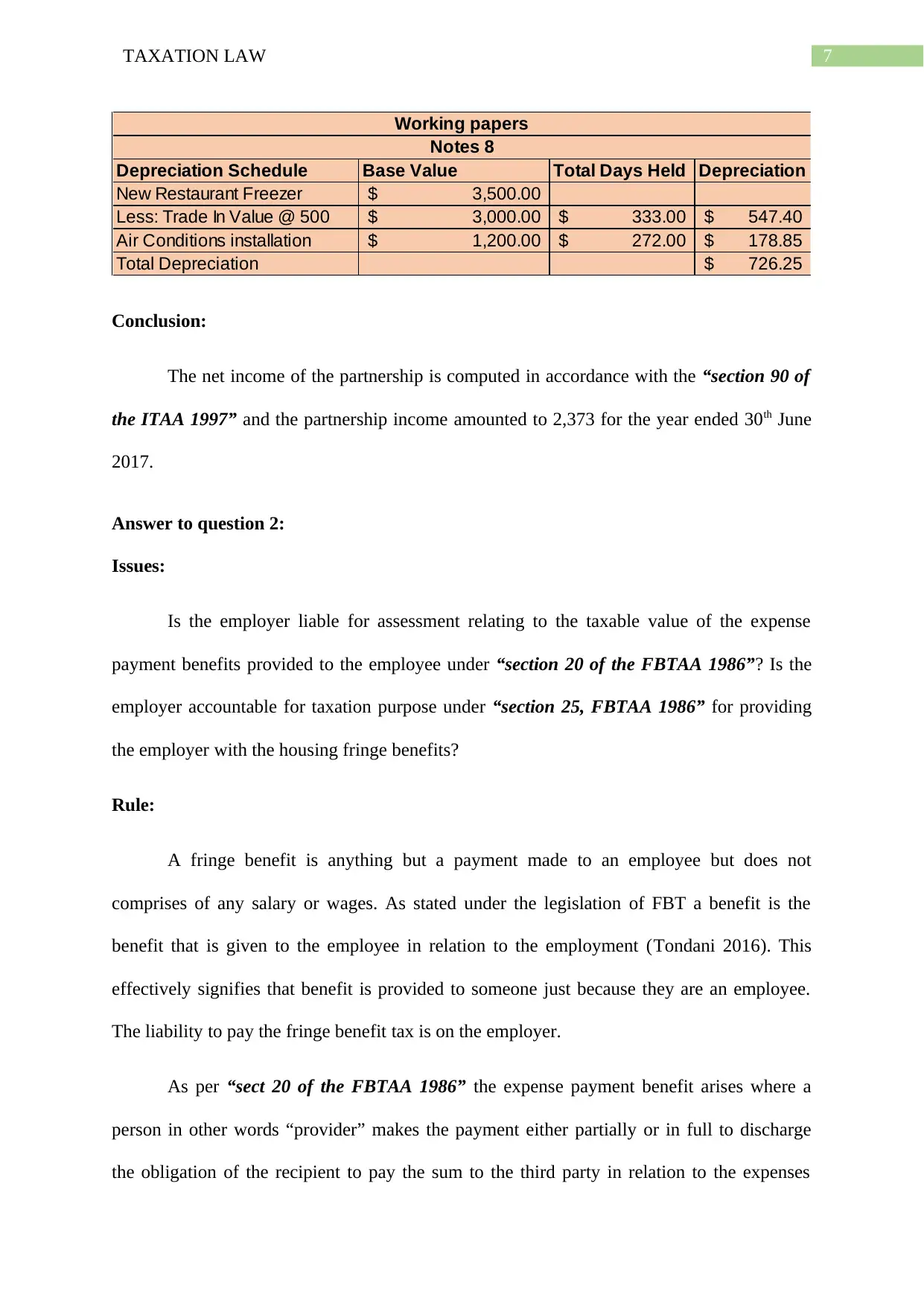
7TAXATION LAW
Depreciation Schedule Base Value Total Days Held Depreciation
New Restaurant Freezer 3,500.00$
Less: Trade In Value @ 500 3,000.00$ 333.00$ 547.40$
Air Conditions installation 1,200.00$ 272.00$ 178.85$
Total Depreciation 726.25$
Working papers
Notes 8
Conclusion:
The net income of the partnership is computed in accordance with the “section 90 of
the ITAA 1997” and the partnership income amounted to 2,373 for the year ended 30th June
2017.
Answer to question 2:
Issues:
Is the employer liable for assessment relating to the taxable value of the expense
payment benefits provided to the employee under “section 20 of the FBTAA 1986”? Is the
employer accountable for taxation purpose under “section 25, FBTAA 1986” for providing
the employer with the housing fringe benefits?
Rule:
A fringe benefit is anything but a payment made to an employee but does not
comprises of any salary or wages. As stated under the legislation of FBT a benefit is the
benefit that is given to the employee in relation to the employment (Tondani 2016). This
effectively signifies that benefit is provided to someone just because they are an employee.
The liability to pay the fringe benefit tax is on the employer.
As per “sect 20 of the FBTAA 1986” the expense payment benefit arises where a
person in other words “provider” makes the payment either partially or in full to discharge
the obligation of the recipient to pay the sum to the third party in relation to the expenses
Depreciation Schedule Base Value Total Days Held Depreciation
New Restaurant Freezer 3,500.00$
Less: Trade In Value @ 500 3,000.00$ 333.00$ 547.40$
Air Conditions installation 1,200.00$ 272.00$ 178.85$
Total Depreciation 726.25$
Working papers
Notes 8
Conclusion:
The net income of the partnership is computed in accordance with the “section 90 of
the ITAA 1997” and the partnership income amounted to 2,373 for the year ended 30th June
2017.
Answer to question 2:
Issues:
Is the employer liable for assessment relating to the taxable value of the expense
payment benefits provided to the employee under “section 20 of the FBTAA 1986”? Is the
employer accountable for taxation purpose under “section 25, FBTAA 1986” for providing
the employer with the housing fringe benefits?
Rule:
A fringe benefit is anything but a payment made to an employee but does not
comprises of any salary or wages. As stated under the legislation of FBT a benefit is the
benefit that is given to the employee in relation to the employment (Tondani 2016). This
effectively signifies that benefit is provided to someone just because they are an employee.
The liability to pay the fringe benefit tax is on the employer.
As per “sect 20 of the FBTAA 1986” the expense payment benefit arises where a
person in other words “provider” makes the payment either partially or in full to discharge
the obligation of the recipient to pay the sum to the third party in relation to the expenses
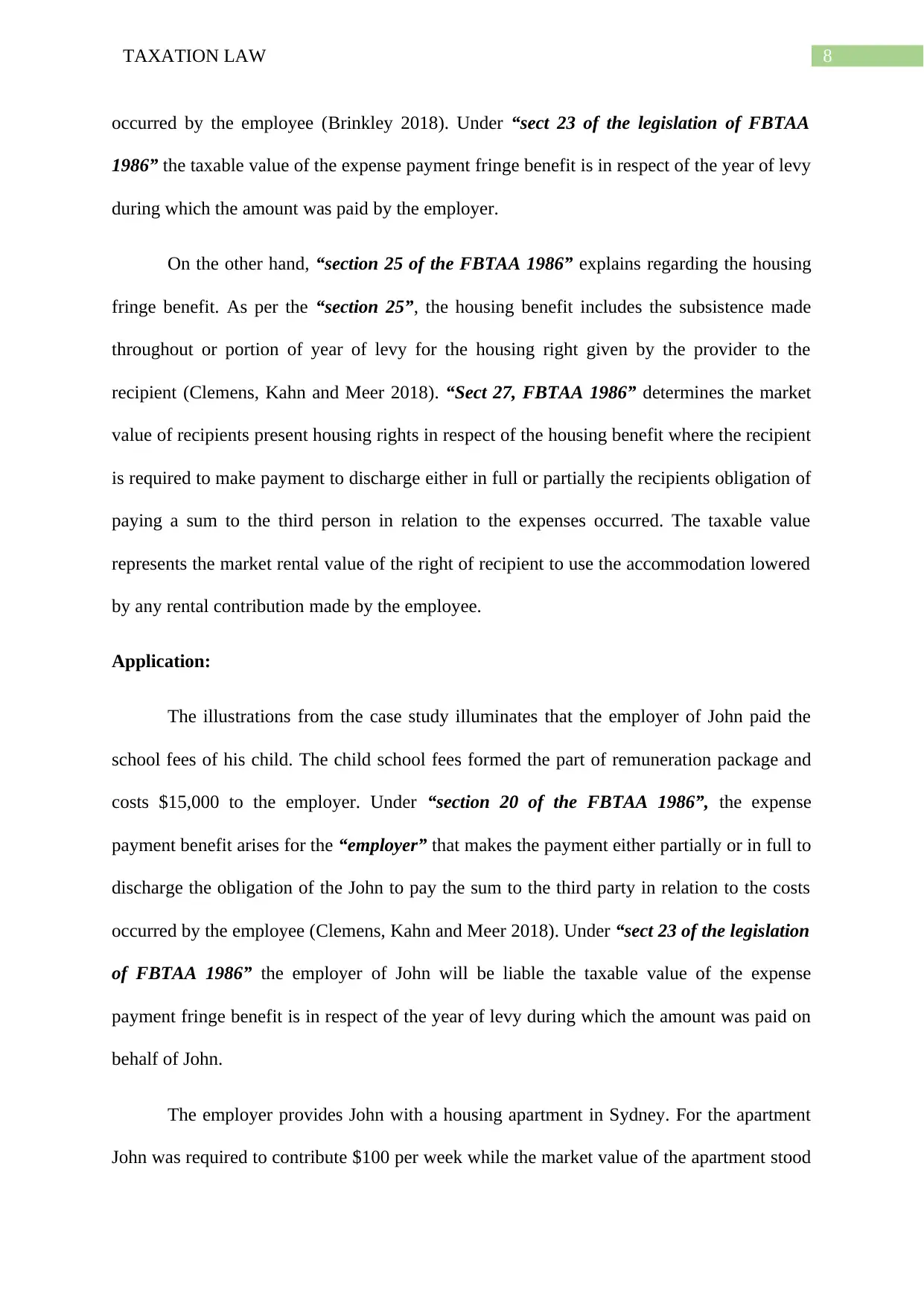
8TAXATION LAW
occurred by the employee (Brinkley 2018). Under “sect 23 of the legislation of FBTAA
1986” the taxable value of the expense payment fringe benefit is in respect of the year of levy
during which the amount was paid by the employer.
On the other hand, “section 25 of the FBTAA 1986” explains regarding the housing
fringe benefit. As per the “section 25”, the housing benefit includes the subsistence made
throughout or portion of year of levy for the housing right given by the provider to the
recipient (Clemens, Kahn and Meer 2018). “Sect 27, FBTAA 1986” determines the market
value of recipients present housing rights in respect of the housing benefit where the recipient
is required to make payment to discharge either in full or partially the recipients obligation of
paying a sum to the third person in relation to the expenses occurred. The taxable value
represents the market rental value of the right of recipient to use the accommodation lowered
by any rental contribution made by the employee.
Application:
The illustrations from the case study illuminates that the employer of John paid the
school fees of his child. The child school fees formed the part of remuneration package and
costs $15,000 to the employer. Under “section 20 of the FBTAA 1986”, the expense
payment benefit arises for the “employer” that makes the payment either partially or in full to
discharge the obligation of the John to pay the sum to the third party in relation to the costs
occurred by the employee (Clemens, Kahn and Meer 2018). Under “sect 23 of the legislation
of FBTAA 1986” the employer of John will be liable the taxable value of the expense
payment fringe benefit is in respect of the year of levy during which the amount was paid on
behalf of John.
The employer provides John with a housing apartment in Sydney. For the apartment
John was required to contribute $100 per week while the market value of the apartment stood
occurred by the employee (Brinkley 2018). Under “sect 23 of the legislation of FBTAA
1986” the taxable value of the expense payment fringe benefit is in respect of the year of levy
during which the amount was paid by the employer.
On the other hand, “section 25 of the FBTAA 1986” explains regarding the housing
fringe benefit. As per the “section 25”, the housing benefit includes the subsistence made
throughout or portion of year of levy for the housing right given by the provider to the
recipient (Clemens, Kahn and Meer 2018). “Sect 27, FBTAA 1986” determines the market
value of recipients present housing rights in respect of the housing benefit where the recipient
is required to make payment to discharge either in full or partially the recipients obligation of
paying a sum to the third person in relation to the expenses occurred. The taxable value
represents the market rental value of the right of recipient to use the accommodation lowered
by any rental contribution made by the employee.
Application:
The illustrations from the case study illuminates that the employer of John paid the
school fees of his child. The child school fees formed the part of remuneration package and
costs $15,000 to the employer. Under “section 20 of the FBTAA 1986”, the expense
payment benefit arises for the “employer” that makes the payment either partially or in full to
discharge the obligation of the John to pay the sum to the third party in relation to the costs
occurred by the employee (Clemens, Kahn and Meer 2018). Under “sect 23 of the legislation
of FBTAA 1986” the employer of John will be liable the taxable value of the expense
payment fringe benefit is in respect of the year of levy during which the amount was paid on
behalf of John.
The employer provides John with a housing apartment in Sydney. For the apartment
John was required to contribute $100 per week while the market value of the apartment stood
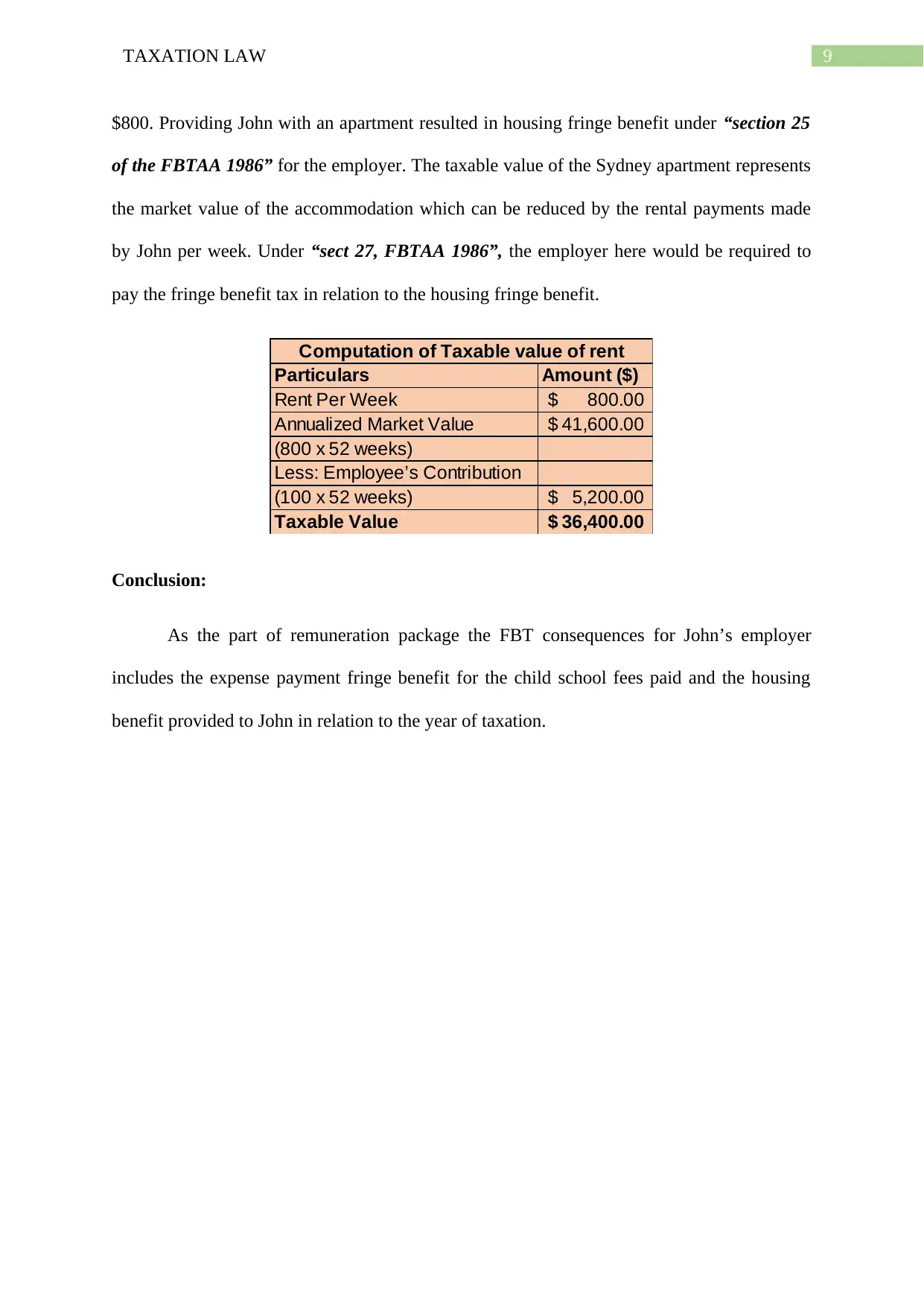
9TAXATION LAW
$800. Providing John with an apartment resulted in housing fringe benefit under “section 25
of the FBTAA 1986” for the employer. The taxable value of the Sydney apartment represents
the market value of the accommodation which can be reduced by the rental payments made
by John per week. Under “sect 27, FBTAA 1986”, the employer here would be required to
pay the fringe benefit tax in relation to the housing fringe benefit.
Particulars Amount ($)
Rent Per Week 800.00$
Annualized Market Value 41,600.00$
(800 x 52 weeks)
Less: Employee’s Contribution
(100 x 52 weeks) 5,200.00$
Taxable Value 36,400.00$
Computation of Taxable value of rent
Conclusion:
As the part of remuneration package the FBT consequences for John’s employer
includes the expense payment fringe benefit for the child school fees paid and the housing
benefit provided to John in relation to the year of taxation.
$800. Providing John with an apartment resulted in housing fringe benefit under “section 25
of the FBTAA 1986” for the employer. The taxable value of the Sydney apartment represents
the market value of the accommodation which can be reduced by the rental payments made
by John per week. Under “sect 27, FBTAA 1986”, the employer here would be required to
pay the fringe benefit tax in relation to the housing fringe benefit.
Particulars Amount ($)
Rent Per Week 800.00$
Annualized Market Value 41,600.00$
(800 x 52 weeks)
Less: Employee’s Contribution
(100 x 52 weeks) 5,200.00$
Taxable Value 36,400.00$
Computation of Taxable value of rent
Conclusion:
As the part of remuneration package the FBT consequences for John’s employer
includes the expense payment fringe benefit for the child school fees paid and the housing
benefit provided to John in relation to the year of taxation.
Secure Best Marks with AI Grader
Need help grading? Try our AI Grader for instant feedback on your assignments.
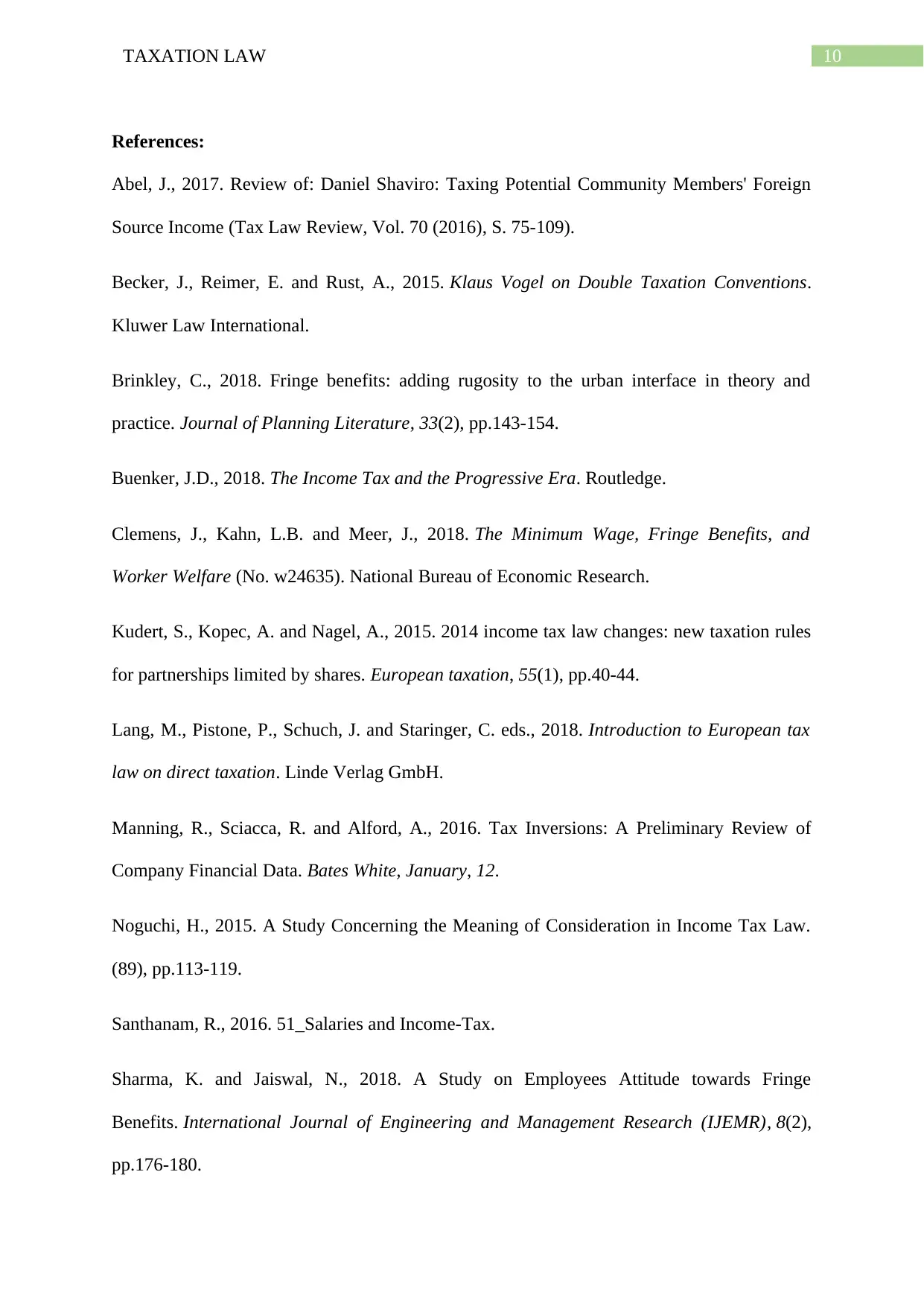
10TAXATION LAW
References:
Abel, J., 2017. Review of: Daniel Shaviro: Taxing Potential Community Members' Foreign
Source Income (Tax Law Review, Vol. 70 (2016), S. 75-109).
Becker, J., Reimer, E. and Rust, A., 2015. Klaus Vogel on Double Taxation Conventions.
Kluwer Law International.
Brinkley, C., 2018. Fringe benefits: adding rugosity to the urban interface in theory and
practice. Journal of Planning Literature, 33(2), pp.143-154.
Buenker, J.D., 2018. The Income Tax and the Progressive Era. Routledge.
Clemens, J., Kahn, L.B. and Meer, J., 2018. The Minimum Wage, Fringe Benefits, and
Worker Welfare (No. w24635). National Bureau of Economic Research.
Kudert, S., Kopec, A. and Nagel, A., 2015. 2014 income tax law changes: new taxation rules
for partnerships limited by shares. European taxation, 55(1), pp.40-44.
Lang, M., Pistone, P., Schuch, J. and Staringer, C. eds., 2018. Introduction to European tax
law on direct taxation. Linde Verlag GmbH.
Manning, R., Sciacca, R. and Alford, A., 2016. Tax Inversions: A Preliminary Review of
Company Financial Data. Bates White, January, 12.
Noguchi, H., 2015. A Study Concerning the Meaning of Consideration in Income Tax Law.
(89), pp.113-119.
Santhanam, R., 2016. 51_Salaries and Income-Tax.
Sharma, K. and Jaiswal, N., 2018. A Study on Employees Attitude towards Fringe
Benefits. International Journal of Engineering and Management Research (IJEMR), 8(2),
pp.176-180.
References:
Abel, J., 2017. Review of: Daniel Shaviro: Taxing Potential Community Members' Foreign
Source Income (Tax Law Review, Vol. 70 (2016), S. 75-109).
Becker, J., Reimer, E. and Rust, A., 2015. Klaus Vogel on Double Taxation Conventions.
Kluwer Law International.
Brinkley, C., 2018. Fringe benefits: adding rugosity to the urban interface in theory and
practice. Journal of Planning Literature, 33(2), pp.143-154.
Buenker, J.D., 2018. The Income Tax and the Progressive Era. Routledge.
Clemens, J., Kahn, L.B. and Meer, J., 2018. The Minimum Wage, Fringe Benefits, and
Worker Welfare (No. w24635). National Bureau of Economic Research.
Kudert, S., Kopec, A. and Nagel, A., 2015. 2014 income tax law changes: new taxation rules
for partnerships limited by shares. European taxation, 55(1), pp.40-44.
Lang, M., Pistone, P., Schuch, J. and Staringer, C. eds., 2018. Introduction to European tax
law on direct taxation. Linde Verlag GmbH.
Manning, R., Sciacca, R. and Alford, A., 2016. Tax Inversions: A Preliminary Review of
Company Financial Data. Bates White, January, 12.
Noguchi, H., 2015. A Study Concerning the Meaning of Consideration in Income Tax Law.
(89), pp.113-119.
Santhanam, R., 2016. 51_Salaries and Income-Tax.
Sharma, K. and Jaiswal, N., 2018. A Study on Employees Attitude towards Fringe
Benefits. International Journal of Engineering and Management Research (IJEMR), 8(2),
pp.176-180.
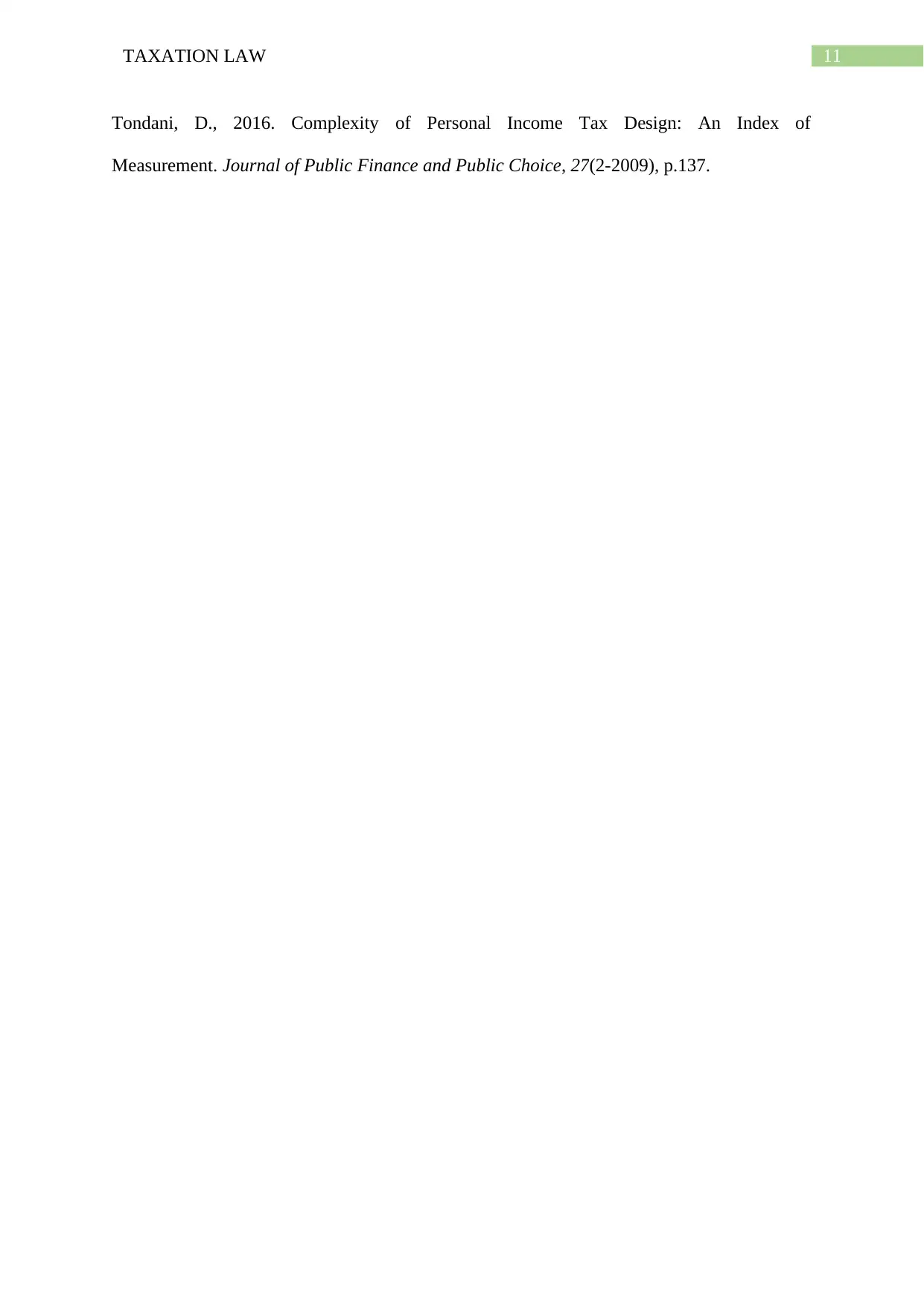
11TAXATION LAW
Tondani, D., 2016. Complexity of Personal Income Tax Design: An Index of
Measurement. Journal of Public Finance and Public Choice, 27(2-2009), p.137.
Tondani, D., 2016. Complexity of Personal Income Tax Design: An Index of
Measurement. Journal of Public Finance and Public Choice, 27(2-2009), p.137.
1 out of 12
Related Documents
Your All-in-One AI-Powered Toolkit for Academic Success.
+13062052269
info@desklib.com
Available 24*7 on WhatsApp / Email
![[object Object]](/_next/static/media/star-bottom.7253800d.svg)
Unlock your academic potential
© 2024 | Zucol Services PVT LTD | All rights reserved.





